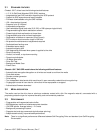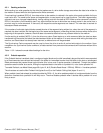CHEETAH 15K.7 SAS PRODUCT MANUAL, REV. F 13
5.2.1 Annualized Failrue Rate (AFR) and Mean time between failure (MTBF)
These drives shall achieve an AFR of 0.55% (MTBF of 1,600,000 hours) when operated in an environment that ensures the
HDA case temperatures do not exceed the values specified in Section 6.4.
Operation at case temperatures outside the specifications in Section 6.4 may increase the AFR (decrease the MTBF). AFR
and MTBF statistics are population statistics that are not relevant to individual units.
AFR and MTBF specifications are based on the following assumptions for Enterprise Storage System environments:
• 8,760 power-on hours per year.
• 250 average on/off cycles per year.
• Operations at nominal voltages.
• Systems will provide adequate cooling to ensure the case temperatures specified in Section 6.4.1 are not exceeded.
5.2.2 Preventive maintenance
No routine scheduled preventive maintenance is required.
5.2.3 Hot plugging the drive
When a disk is powered on by switching the power or hot plugged, the drive runs a self test before attempting to
communicate on its’ interfaces. When the self test completes successfully, the drive initiates a Link Reset starting with OOB.
An attached device should respond to the link reset. If the link reset attempt fails, or any time the drive looses sync, the drive
initiated link reset. The drive will initiate link reset once per second but alternates between port A and B. Therefore each port
will attempt a link reset once per 2 seconds assuming both ports are out of sync..
If the self-test fails, the does not respond to link reset on the failing port.
Note. It is the responsibility of the systems integrator to assure that no temperature, energy, voltage hazard, or ESD
potential hazard is presented during the hot connect/disconnect operation. Discharge the static electricity from
the drive carrier prior to inserting it into the system.
Caution. The drive motor must come to a complete stop prior to changing the plane of operation. This time is required to
insure data integrity.
5.2.4 S.M.A.R.T.
S.M.A.R.T. is an acronym for Self-Monitoring Analysis and Reporting Technology. This technology is intended to recognize
conditions that indicate imminent drive failure and is designed to provide sufficient warning of a failure to allow you to back up
the data before an actual failure occurs.
Note. The drive’s firmware monitors specific attributes for degradation over time but can’t predict instantaneous drive
failures.
Each monitored attribute has been selected to monitor a specific set of failure conditions in the operating performance of the
drive and the thresholds are optimized to minimize “false” and “failed” predictions.
Controlling S.M.A.R.T.
The operating mode of S.M.A.R.T. is controlled by the DEXCPT and PERF bits on the Informational Exceptions Control
mode page (1Ch). Use the DEXCPT bit to enable or disable the S.M.A.R.T. feature. Setting the DEXCPT bit disables all
S.M.A.R.T. functions. When enabled, S.M.A.R.T. collects on-line data as the drive performs normal read and write
operations. When the PERF bit is set, the drive is considered to be in “On-line Mode Only” and will not perform off-line
functions.
You can measure off-line attributes and force the drive to save the data by using the Rezero Unit command. Forcing
S.M.A.R.T. resets the timer so that the next scheduled interrupt is in two hours.
You can interrogate the drive through the host to determine the time remaining before the next scheduled measurement and
data logging process occurs. To accomplish this, issue a Log Sense command to log page 0x3E. This allows you to control
when S.M.A.R.T. interruptions occur. Forcing S.M.A.R.T. with the RTZ command resets the timer.


















